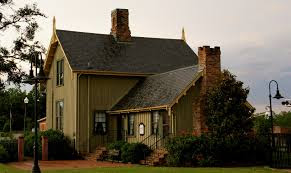Imagine a small, bustling community taking shape in a remote, isolated area and growing with the development of agriculture, naval stores and iron works. That scene is an early picture of what is now Lee County (before it was carved in 1907 from Moore and Chatham counties).
 Commerce was initially transported over unpaved roads and waterways — the Cape Fear and Deep rivers. Once coal was mined commercially and added to other products of the local economy, a rail connection was indispensable for further growth.
Commerce was initially transported over unpaved roads and waterways — the Cape Fear and Deep rivers. Once coal was mined commercially and added to other products of the local economy, a rail connection was indispensable for further growth.At the junction of two new railroads, the community of Sanford began to take shape in the 1860s, and soon T. W. Tucker arrived to manage the burgeoning rail business. As the first depot agent for the Raleigh and Augusta Air Line Railroad, he and his family became the initial residents of the Railroad House, the oldest house in the city.
Built near the depot in the center of town in 1872, two years before Sanford itself was incorporated, the classic Gothic Revival frame cottage has always occupied a very prominent spot in the community and demonstrates that the city was originally a railroad town. Because the city was named for C.O. Sanford, the chief civil engineer for the railroad, the influence of transportation is clearly important.
The well-being of the Railroad House has had its peaks and valleys. Fortunately, today it is thriving as a principal component of Depot Park, which has evolved into the cultural and communal center of Sanford where concerts and events are held and families play and enjoy leisure time. However, the stability of the house was not so certain several decades ago.
While Tucker and his family lived at the Railroad House, a school for girls was run there by his wife Inder. Because Tucker was also Sanford’s first mayor, the house flourished as a mainstay of community life. However, its importance began to fade. In 1916 the railroad sold the then 44-year-old house, which next became the home for several families before it was used as a tea room.
Because the house had deteriorated, it was scheduled for demolition in 1962. However, interested citizens banded together to save it and formed the Railroad House Historical Association. Through their efforts the house was moved across the street to its current location, restored and given a new life first as the home of the Chamber of Commerce for 30 years and now as the only historical museum of Lee County.
“Interesting artifacts are located throughout the house,” says Emily Mierisch, who volunteers regularly at the Railroad House because “I just love history.” With historical photos, objects and documents of the area’s early days, the house is indispensable in preserving local history as itself is being preserved.
A historic steam engine, known as Old No. 12, anchors an important part of the landscape near the house. With two small wheels in front and eight large driving wheels, it was placed in service in 1911 and officially retired in 1955.
Also part of the park is the passenger depot (circa 1900), a one-story brick structure typical of its period and renovated in 1976. Its charming, wide, overhanging red tile roof with flared eaves almost rivals the artistic architecture of the Railroad House.
The house’s central chimney with a recessed lancet panel (inspired by the beauty of cathedral windows) on each face and a crenellated cap adds an antiquated charisma to Sanford’s historic district that encompasses 53 buildings, most dating from 1895 to 1930.
The Railroad House’s simple board-and-batten siding is enriched in the front by decorative features such as central double windows, each with a four-over-four sash. Other embellishments include gables on the main roof, two dormers and entrance porch that are ornamented with a finial and cross-bracing.
The interior of the house is finished in simple fashion with wide beaded baseboards and plaster walls. The original floors are mostly intact, and the mantels have a typical nineteenth-century design. The house consists of a one-and-half-story main block, which has three rooms on the lower level, and a one-story rear wing with its own chimney.
Visiting the Railroad House, which is listed on the National Register of Historic Places, is a great way to celebrate local and national history.
Note: The post is based on my article about the Railroad House published in the April 2020 issue of OutreachNC Magazine.





No comments:
Post a Comment